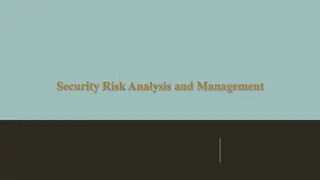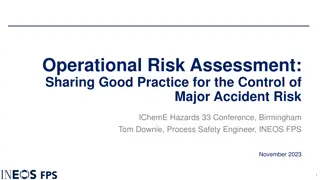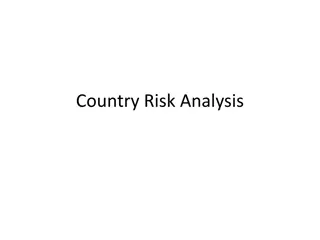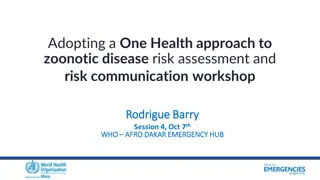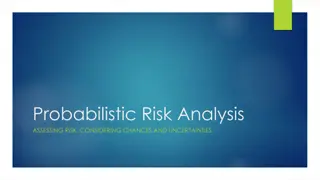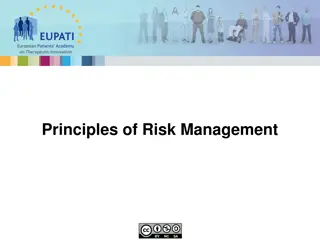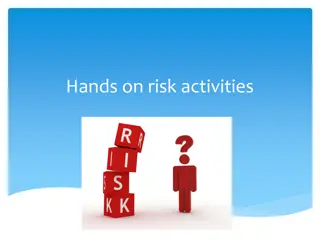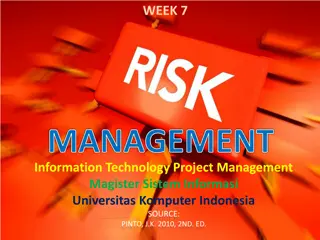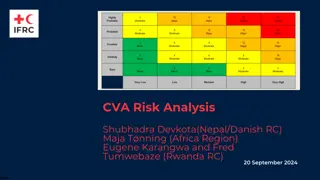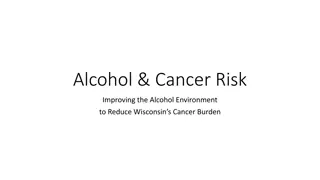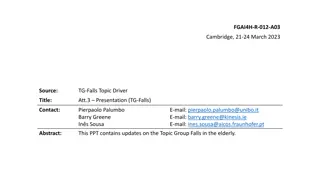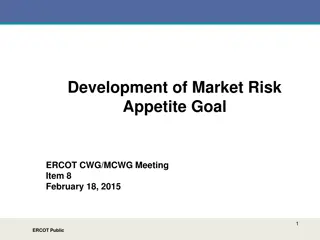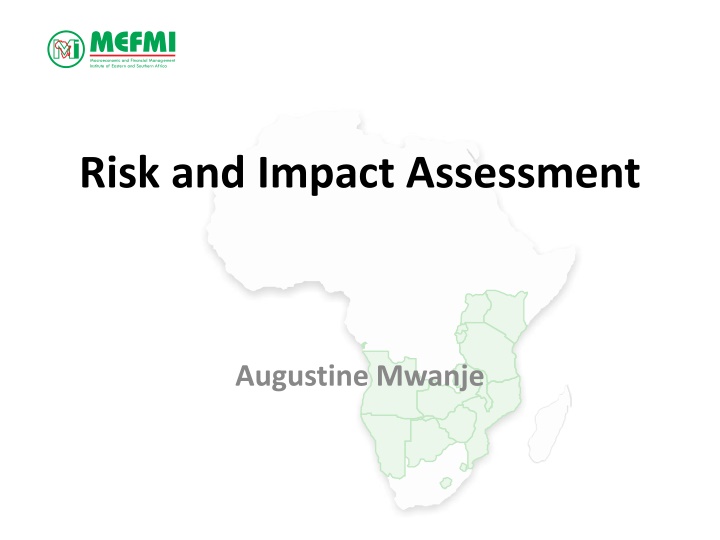
Risk Assessment in Macroeconomic and Financial Management Institute
Explore key issues in risk assessment at the Macroeconomic and Financial Management Institute of Eastern and Southern Africa, covering topics such as consumer compliance risk, inherent risks, and categories of risks. Gain insights into market conduct, internal controls, and impact assessments in the context of risk management.
Download Presentation

Please find below an Image/Link to download the presentation.
The content on the website is provided AS IS for your information and personal use only. It may not be sold, licensed, or shared on other websites without obtaining consent from the author. If you encounter any issues during the download, it is possible that the publisher has removed the file from their server.
You are allowed to download the files provided on this website for personal or commercial use, subject to the condition that they are used lawfully. All files are the property of their respective owners.
The content on the website is provided AS IS for your information and personal use only. It may not be sold, licensed, or shared on other websites without obtaining consent from the author.
E N D
Presentation Transcript
Macroeconomic and Financial Management Institute of Eastern and Southern Africa Risk and Impact Assessment Augustine Mwanje
Macroeconomic and Financial Management Institute of Eastern and Southern Africa What is Risk? Risk is Threat Opportunity The possibility that an event will occur that will impact the achievement of objectives 2
AGENDA Macroeconomic and Financial Management Institute of Eastern and Southern Africa Key Issues in Risk Assessment Market Conduct Risk Assessment Process Significant Activities Internal Controls Impact Assessment
Macroeconomic and Financial Management Institute of Eastern and Southern Africa Key Issues in Risk Assessment Consumer compliance risk, in general, is the risk of legal or regulatory sanctions, financial loss, consumer harm, or damage to reputation caused by a failure to comply with or adhere: To consumer protection laws, regulations, or standards To the organization s own policies, procedures, codes of conduct, and ethical standards To principles of integrity and fair dealing applicable to the organization s business activities and functions
Macroeconomic and Financial Management Institute of Eastern and Southern Africa Key Issues in Risk Assessment Inherent Risk Inherent consumer compliance risk is the risk associated with product and service offerings, practices, or other activities that could result in significant consumer harm or contribute to an institution s noncompliance with consumer protection laws and regulations.
Macroeconomic and Financial Management Institute of Eastern and Southern Africa Key Issues In Risk Assessment Categories of Inherent Risks Inclusive and competitive marketplace Transparency and marketing Suitability Professional Ethics and Standards Due care Safety and security risk Legal Environment (compliance)
Macroeconomic and Financial Management Institute of Eastern and Southern Africa Key Issues in Risk Assessment Objectives The goal is to allow supervisory staff to establish reasonable, but not absolute, assurance that material residual consumer compliance risks are identified. The risk assessment can then be relied upon as the determinant of the scope of examination activities.
Macroeconomic and Financial Management Institute of Eastern and Southern Africa The Risk Management Process Risk Identification Risk Measurement Risk Monitoring Risk Reporting Risk Identification
Macroeconomic and Financial Management Institute of Eastern and Southern Africa Key Issues in Risk Assessment Elements a good risk management system Active Board and Senior Management Oversight Adequate Policies, Procedures and Limits Adequate Risk Monitoring and Management Information Systems (MIS) Adequate Internal Controls
Macroeconomic and Financial Management Institute of Eastern and Southern Africa Market Conduct Risk Assessment A risk profile helps identify the acceptable level of risk a Financial Institution is prepared to accept It also attempts to determine how the Financial Institution s willingness to take risk (or aversion to risk) will affect its overall decision-making strategy To help determine the risk based supervisory strategies that examiners will adopt for a specific Institution, a good understanding of the Financial Institution s risk profile is necessary 10
Macroeconomic and Financial Management Institute of Eastern and Southern Africa Market Conduct Risk Assessment Residual product risk considers the impact (inherent risk) and probability (risk management) of non-compliance. Residual risk is the risk that remains after determining the level of inherent risk and reaching a conclusion about the effectiveness of risk controls associated with the institution s material products.
Macroeconomic and Financial Management Institute of Eastern and Southern Africa Market Conduct Risk Assessment Updating the Risk Assessment Pre-examination Post-examination Ongoing supervision Significant risk-profile changes
Macroeconomic and Financial Management Institute of Eastern and Southern Africa Market Conduct Risk Assessment Source: Consumer Financial Protection Bureau
Macroeconomic and Financial Management Institute of Eastern and Southern Africa Risk Matrix Activity/ Product/ Risk Inherent Level of Risk Quality of Risk Management Aggregate Level Of Risk Direction of Risk A High Acceptable Moderate Increasing B High Acceptable Moderate Increasing C High Acceptable Moderate Stable D High Acceptable Moderate Increasing E High Weak High Increasing Overall Risk High Acceptable Moderate Increasing
Risk Matrix Macroeconomic and Financial Management Institute of Eastern and Southern Africa Activity/ Product/ Risk Inherent Level of Risk Quality of Risk Management Aggregate Level Of Risk Direction of Risk A High Acceptable Moderate Increasing B High Acceptable Moderate Increasing C High Acceptable Moderate Stable D High Acceptable Moderate Increasing E High Weak High Increasing Overall Risk High Acceptable Moderate Increasing
Risk Matrix Macroeconomic and Financial Management Institute of Eastern and Southern Africa Activity/ Product/ Risk Inherent Level of Risk Quality of Risk Management Aggregate Level Of Risk Direction of Risk A High Acceptable Moderate Increasing B High Acceptable Moderate Increasing C High Acceptable Moderate Stable D High Acceptable Moderate Increasing E High Weak High Increasing Overall Risk High Acceptable Moderate Increasing
Macroeconomic and Financial Management Institute of Eastern and Southern Africa Examination Cycle Time Allocation Planning Execution Reporting Planning Execution Reporting Planning Execution Reporting Planning Execution Reporting
Macroeconomic and Financial Management Institute of Eastern and Southern Africa Significant Activities A significant activity is a line of business, unit or process that is fundamental to the Financial Institution s business model and its ability to meet its overall business objectives. Retail products, services, other activities that are material to the institution overall product mix.
Macroeconomic and Financial Management Institute of Eastern and Southern Africa Significant Activities Criteria used to identify significant activities can be Qualitative or Quantitative Identification of significant activities can be a subjective process and there is therefore no one-size-fits-all approach
Macroeconomic and Financial Management Institute of Eastern and Southern Africa Internal Control Effective internal controls are the foundation for the safe, sound, and compliant operation of a financial institution. The starting point for internal control assessment is understanding the Institution s control environment The control environment consists of the governance and management functions and the attitudes, awareness and actions of the management about internal control.
Macroeconomic and Financial Management Institute of Eastern and Southern Africa Internal Control An Institution s control environment comprises of the following elements: Communication and enforcement of integrity and ethical values Commitment to competence Participation by those charged with governance Management s philosophy and operating style Organisational structure Assignment of authority and responsibility Human resources policies and practices
Macroeconomic and Financial Management Institute of Eastern and Southern Africa Impact Assessment Allows supervisors to separate systematically important Financial Services Providers so they can be closely monitored. Impact rating measures the potential impact of the failure of a significant financial services provider s market conduct outcomes on consumer conduct and trust on a well- functioning financial market.
Macroeconomic and Financial Management Institute of Eastern and Southern Africa Impact Assessment Impact Rating indicators Consumer coverage (geographical, vulnerable groups, number of consumers using products) Nature of products (variety, complexity, technology) Market power (pricing of products, business & technological know how) Intermediation (scale, models, channels) Interconnectedness (supply chain)
Macroeconomic and Financial Management Institute of Eastern and Southern Africa Thank You Any Questions? 24
Macroeconomic and Financial Management Institute of Eastern and Southern Africa References and Bibliography Canada s Office of the Superintendent of Financial Institutions (OSFI ) Supervisory Framework, August 1999 (Revised December 2010) AFI 2016 Guideline Note No.21: Market Conduct Supervision of Financial Services Providers A Risk-Based Supervision Framework 25

